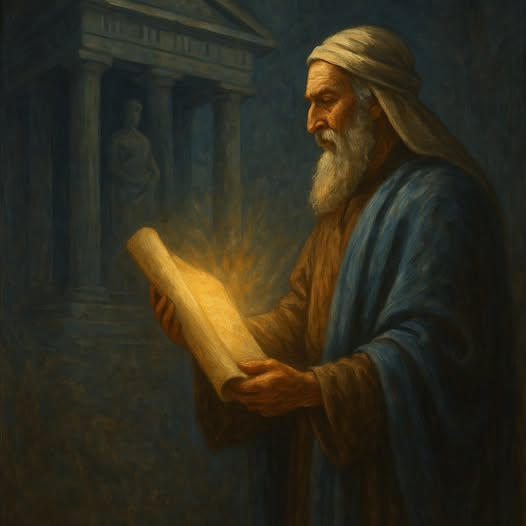
Modern debates about the age of the Earth are not about whether God created. They are about how we read Genesis. One group insists that faithfulness to Scripture requires belief in a six-thousand-year-old Earth. Another believes that the biblical text allows for an ancient cosmos. Both affirm the authority of the Bible. The difference lies in how the text is interpreted, and whether it was ever meant to answer the question we are asking.
The Case for a Young Earth
Young Earth Creationists point to the structure of Genesis 1, where the six days of creation are each marked by the phrase “evening and morning.” This is taken to mean literal, consecutive, twenty-four-hour days. Supporters also cite Exodus 20:11, which links the six days of creation to the six-day human work week: “For in six days the LORD made the heavens and the earth.” This, they argue, leaves no room for ambiguity.
The genealogies in Genesis 5 and 11 are often treated as complete chronologies. When added together and extended to the time of Christ, they produce a timeline that places creation around 4000 BC. This forms the basis for the claim that the Earth is roughly six to ten thousand years old. Theologically, this view defends the idea that death entered the world only after Adam sinned. If animals died before the Fall, it is said, then death is not the result of sin, and the gospel is undermined.
The Case for an Old Earth
Yet this reading is not the only possible or faithful interpretation. The Hebrew word yom, translated “day”, can mean a twenty-four-hour period, but it can also mean a longer span of time or even an undefined era. Genesis 2:4 speaks of “the day” that the LORD God made the heavens and the earth, summarizing the entire week as one day. The creation of light on Day One, without the sun until Day Four, complicates any simplistic understanding of a solar day.
More significantly, the seventh day never ends. There is no “evening and morning” on Day Seven, and the author of Hebrews draws on this in chapter 4 to argue that God’s rest continues. This suggests that the “days” in Genesis 1 are not uniform slices of time but part of a literary structure. The pattern of three days forming and three days filling supports this. Genesis is declaring purpose, order, and intent, not offering a stopwatch.
This view does not come from trying to fit science into Scripture. It comes from the text itself. It respects the literary and theological richness of the passage, recognizing that Genesis is a polemic against pagan chaos myths. It is not attempting to give modern geological data but to assert that Yahweh alone created, ordered, and reigns over all.
The Problem with Using Genealogies for Dating
One of the pillars of the Young Earth model is the assumption that the genealogies in Genesis provide an unbroken timeline from Adam to Abraham. But this assumption falls apart under scrutiny. Biblical genealogies are not modern ancestry charts. They are theological documents. The Hebrew word for “begot” does not always imply direct fatherhood. It often means descent through any number of generations.
Scripture itself shows this. Ezra 7 skips several generations compared to 1 Chronicles 6. Matthew’s genealogy of Jesus in Matthew 1 leaves out names found elsewhere. This is not a problem for biblical writers because completeness was never the point. These genealogies are structured for theological emphasis, often using numbers symbolically, three sets of fourteen in Matthew, lifespans like 365 and 777 in Genesis. These are literary patterns, not historical accounting.
To make things worse for date calculations, the Masoretic Text, the Septuagint, and the Samaritan Pentateuch all give different numbers for the same genealogies. The differences can amount to hundreds of years. If Scripture intended us to build a chronology from these numbers, it would not present us with conflicting versions. The evidence shows clearly that the genealogies are not meant to be used to calculate the age of the Earth.
What Did Second Temple Jews Believe?
To truly understand how Genesis was read in the time of Jesus, we must look at the literature of Second Temple Judaism. These texts show that the question of the Earth’s age was not even a concern. Writers were focused on cosmology, theology, and divine order, not on building a timeline.
The Book of Jubilees divides time into symbolic units of forty-nine years, emphasizing patterns of covenant and sacred history. It never attempts to produce a geological calendar. First Enoch expands the creation narrative into an elaborate account of cosmic order, angelic roles, and heavenly timekeeping. Its Astronomical Book presents calendars and cosmologies that are anything but literalistic.
Philo of Alexandria, a contemporary of Jesus, explicitly rejected a literal interpretation of Genesis 1. He taught that the creation days were not temporal at all but represented logical sequences of divine action. The Genesis Apocryphon and other Dead Sea Scrolls writings reflect a concern for priestly interpretation and messianic patterns, not chronological frameworks.
In the world of Second Temple Judaism, time was not measured in solar days or geological strata. It was measured in temple cycles, jubilees, festivals, and prophetic fulfillment. Genesis was understood theologically, not scientifically. The idea that it should serve as a historical clock would have seemed alien.
Was Young Earth Creationism the View of the Early Church?
Contrary to popular belief, the modern Young Earth model is not the historic view of the Church. The early Church Fathers approached Genesis with reverence but did not always interpret it as a literal, step-by-step historical account. For many, the text had layers of meaning, spiritual, allegorical, and theological, and the physical details were often considered secondary to deeper truths.
Origen, writing in the third century, explicitly rejected a purely literal reading of the creation account. He argued that certain elements, such as God planting a garden and walking in it during the cool of the day, could not be understood in a strictly physical sense. To him, such passages were designed to draw the reader into a deeper spiritual understanding. Origen viewed the six days of creation as a literary structure to communicate theological truths, not as a chronological sequence.
Augustine took this even further. In On the Literal Interpretation of Genesis, Augustine stated that God created everything at once, instantaneously. He saw the six days as a logical framework that allowed human minds to comprehend the order and beauty of creation, not as a literal timetable. He was skeptical of using Genesis as a source for scientific or chronological detail, urging caution and humility in interpreting the text.
Other early Christian thinkers, such as Basil the Great and Ambrose, spoke of the days of creation more literally, but even they allowed for flexibility and saw value in symbolic meanings. There was no uniform doctrine requiring belief in a young earth or a strict six-day creation. The diversity of thought among the Church Fathers shows that early Christianity was not bound to a single interpretation of Genesis.
The belief in a recent creation date developed centuries later. Archbishop James Ussher’s 4004 BC timeline, calculated in the 17th century, became famous for its precision, but it was never doctrinal. Ussher compiled genealogies from the Bible and correlated them with ancient history and astronomical events. His chronology became influential because it was printed in the margins of many King James Bibles, but this was a scholarly reconstruction, not a binding theological position.
The Rise of Modern Young Earth Creationism
What we now recognize as Young Earth Creationism is a product of the 20th century. It emerged primarily as a reaction to the rise of Darwinism and the perceived threat of modern science. George McCready Price, a Seventh-Day Adventist and amateur geologist, was one of its key architects. Drawing from the visions of Ellen G. White, he championed the idea of flood geology, claiming that the entire fossil record could be explained by the biblical Flood.
Later, institutions like the Institute for Creation Research (founded by Henry Morris) and Answers in Genesis (led by Ken Ham) expanded this view into a full-blown movement. They insist that a young earth and six literal 24-hour days are essential to a faithful reading of Scripture. However, this interpretation is neither ancient nor universal, it is a modern response framed in opposition to secular scientific narratives. While it appeals to many today, it represents a relatively recent innovation in the long history of Christian thought.
Conclusion
The Bible is absolutely clear that God created the heavens and the earth. It is also clear that creation was intentional, ordered, and good. But it never demands allegiance to a specific age of the Earth. Genesis 1 is not a scientific paper. It is a theological declaration. It opposes the pagan myths of its time by proclaiming a sovereign God who creates not through violence or chaos but through word and wisdom.
Both Young Earth and Old Earth views can be held by faithful Christians, but only if they are rooted in what the text actually says. For too long, genealogical math and imported assumptions have overshadowed the richness of Genesis. Interpreting it rightly means recovering its purpose, not to answer modern questions about sedimentary layers, but to reveal the character of the Creator.
Discussion Questions
- Why is it important to understand the genre and purpose of Genesis before applying it to modern scientific questions?
- What evidence suggests that the early Church Fathers did not hold to a Young Earth Creationist timeline?
- How did Second Temple Jewish literature engage with the Genesis creation account, and what does that reveal about their cosmology?
- In what ways has the interpretation of Genesis 1 changed in response to modern science, and is that necessarily a compromise?
- Can a Christian affirm the authority of Scripture and still hold to an Old Earth view? Why or why not?
Want to Know More?
- The Lost World of Genesis One – John H. Walton
Written by a professor of Old Testament, this book argues that Genesis 1 is not about the material creation of the world but about assigning functions and roles within a sacred space. Walton shows how Genesis reflects Ancient Near Eastern ideas of temple inauguration, suggesting the text is theological rather than scientific in nature. - Genesis: History, Fiction, or Neither? – Charles Halton (ed.)
This volume presents a scholarly debate among three authors: James Hoffmeier, Gordon Wenham, and Kenton Sparks. Each provides a different approach to interpreting Genesis—literal history, theological narrative, and mythic storytelling—offering readers a comprehensive view of how faithful Christians can arrive at different conclusions. - Reading Genesis Well: Navigating History, Poetry, Science, and Truth in Genesis 1–11 – C. John Collins
Collins, a respected conservative scholar, argues that Genesis uses literary artistry and symbolic language, but still conveys real historical truth. He warns against flat literalism, showing how ancient genre and context help us grasp what the text is really saying—without surrendering biblical authority. - In the Beginning… We Misunderstood – Johnny V. Miller & John M. Soden
This accessible book explores how sincere Christians have wrestled with Genesis and science. The authors argue for a non-literal understanding of the days of creation while maintaining a strong commitment to the Bible’s truthfulness, bridging the gap between faith and reason for lay readers. - The Bible, Rocks and Time: Geological Evidence for the Age of the Earth – Davis A. Young & Ralph F. Stearley
Written by two Christian geologists, this academic yet readable work dismantles the scientific claims of Young Earth Creationism. It walks through geological data, the history of science, and the biblical text—demonstrating that belief in an old Earth is not incompatible with a high view of Scripture.






